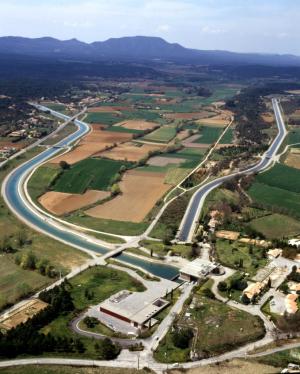Canal de Provence: a most precious resource
Marseille's largest and most spectacular monument is not a cathedral, nor a castle, nor a government building. It is a water tower, built in the 1860s to celebrate the completion of the "Canal de Marseille" and the arrival of the Durance waters in the city.
The size of the Palais Longchamp and its exuberant architecture tell a lot about the importance of water in this region. For the past two millennia, Roman generals, medieval and Renaissance engineers, 19th century entrepreneurs and present-day public authorities have dug canals and raised aqueducts to provide water to the parched lands of Lower Provence.
Of all these achievements, the Canal de Provence is one of the most ambitious and has proved the most effective.
The vast hydroelectric development program of the late 1950s had provided the Durance and Verdon Rivers with powerful dams, huge water reservoirs and wide canals—like the one running along the Durance riverbed close to Cadarache.
These new facilities, which account for 10 percent of the national hydroelectric potential, presented the local governments with a historical opportunity. A "global approach" to the water issue could at last be implemented, and in 1957 the departments of Var and Bouches-du-Rhône, along with the City of Marseille, established a new authority to manage and distribute the precious resource. Water, now plentiful and available all through the year, was to be the key to the area's economic development.
Half a century and EUR 2 billion of investment later, the Société du Canal de Provence (SCP) delivers water to more than two million people in 110 towns and villages; 6,000 farms with a total of 45,000 irrigated hectares, and 500 factories large and small.
SCP's network of canals (sometimes shared with the French Energy Authority, EDF) tunnels and aqueducts runs for close to 700 kilometres from Gréoux-les-Bains to the water reservoirs in the Marseille, Aix and Toulon area.
Like Cadarache installations, ITER will draw on SCP's water—cooling the machine will require some 1.7 million cubic metres of water a year, two-thirds of which will evaporate, while approximately one-third will be returned to the Durance River. Altogether, ITER's consommation will account for less than 0.25 percent of the 230 million cubic metres the network transports every year.




